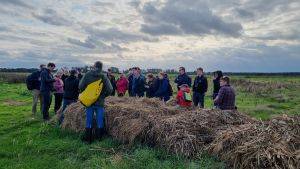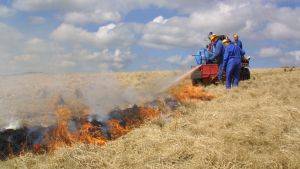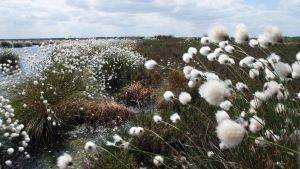Exmoor: Mires Partnership
Introduction
The Exmoor Mires Partnership is a carefully planned restoration programme targeted at over 3000 ha of moorland. Part of South West Water’s Upstream Thinking Catchment Management Programme, which enables issues at source in the catchment to be adressed rather than investing in storage and treatment works further down the river.
Description
For years, the mires of Exmoor have been regarded only as a source of peat fuel or grazing land to be cut into and drained to maximise production. This damage has changed the eco-hydrological functioning of the mires, leading to a purple moor grass Molinia-dominated vegetation and reducing the provision of ecosystem services. The Exmoor Mires Partnership is working with landowners and moorland users to re-assess the way bogs are regarded and managed. With the support of this partnership, hundreds of kilometres of old ditches and abandoned peat cuttings are being blocked up, gradually restoring their ecological and hydrological functions. The end result will be wetter, healthier peatlands, which supply a wide range of ecosystem services.
Project Aims
3000 ha of moorland by March 2020
Restoration Delivered
Since 1998, the Exmoor Mires Partnership has:
- Surveyed 3,362 ha
- Surveyed 246,590 m of ditches
- Restored 1,948 ha
- Blocked 195,097 m of ditches, with a total of 22,343 ditch blocks installed
The Exmoor Mires Partnership History
When the Exmoor Mires Partnership formed in 1999, the group started to think about how the function of Exmoor Rivers was linked to the mires on the moors above. They began a small programme of ditch blocking at the head of the River Exe and in 2006 with the inclusion of a new funding-partner, South West Water, they expanded the project. Since 1999, the partnership has continued to grow, and in 2010 the project evolved once again to a major landscape restoration and research project with a target of 3000 ha of mire restoration on Exmoor.
The Exmoor Mires Partnership now includes representatives from all of the groups concerned with managing moorlands. The governance and decision making of the Exmoor Mires Partnership is now firmly in the hands of the moorland stakeholders and this has resulted in significant changes on the ground. The thin peats and steep slopes of the mires on Exmoor lead to innovative solutions to ditch blocking and the techniques used on moorlands elsewhere in the UK have been adapted to suit the Exmoor situation e,g, using natural on-site materials, such as peat and bale dams and locally sourced timber. The aim is to widen the range of ecosystem services delivered from blanket peatlands in the South West of England.
The Exmoor Mires Partnership is now monitoring the consequences of contemporary restoration of damaged mire landscapes in a holistic manner. The specific elements being monitored include water quality, supply, flood risk change, carbon storage and greenhouse gas fluxes, agricultural economic impacts, historic environment and biodiversity changes. A comprehensive pre-restoration understanding of mire structure and function has been established, describing all relevant ecosystem services. This data will be compared to the post-restoration data to determine the effect of mire restoration on all the ecosystem services listed. The information will enable the quantification and valuing of key services such as clean water supplies and greenhouse gas emissions reduction, leading, it is hoped, to a sustainable way of rewarding moorland landowners for the provision of these services alongside food production.
Partners
Partners include:
- South West Water
- Environment Agency
- Exmooor National Park
- Historic England
- Natural England
- Exmoor Society
- and universities including: Exeter, Bristol and Plymouth
Project Name: Exmoor: Mires Partnership
Organisation / Lead partner: Exmoor Mires Partnership
Location: Dulverton, West Somerset
Approximate area covered: 3000 ha
Conservation Status: Site of Special Scientific Interest (SSSI), National Park (NP)
Predominately: Upland
Peat Habitats: Blanket bog
Project Type: Restoration, Management, Research, Citizen science/ community engagement.
Year Project Began: 1998











